Exploring the Evolution Trend of China’s Digital Carbon Footprint: A Simulation Based on System Dynamics Approach
Abstract
1. Introduction
2. Literature Review
2.1. Reviews of Digital Carbon Footprint
2.2. Reviews of Pathway Simulation of Carbon Emissions
2.3. Reviews of Carbon Emission Prediction Based on SD Model
3. Research Methodology
3.1. System Boundaries and Model Assumption
3.2. Subsystem Division
3.3. Digital Carbon Footprint SD Model Construction
3.3.1. Digital Carbon Footprint Causality Analysis
3.3.2. Digital Carbon Footprint Stock–Flow Diagram
3.4. Data Sources and Parameter Setting
3.5. Model Validity Test
3.6. Digital Carbon Footprint Scenario Designs
4. Digital Carbon Footprint Simulation Results Analysis
4.1. Result of Model Validity Test
4.2. Analysis of the Development Trend under the Different Scenarios
4.2.1. Analysis of the Result of Baseline Scenario
4.2.2. Analysis of the Result of DPDE Scenario
4.2.3. Analysis of the Result of DPDCPC Scenario
4.2.4. Analysis of the Result of DEGR Scenario
4.2.5. Analysis of the Result of Comprehensive Adjustment Scenario
5. Discussion
6. Conclusions and Policy Implications
6.1. Conclusions
6.2. Policy Implications
Author Contributions
Funding
Institutional Review Board Statement
Informed Consent Statement
Data Availability Statement
Conflicts of Interest
Appendix A
| Parameters | Parameter Value/Equation | Unit | Parameter Sources |
|---|---|---|---|
| GDP growth rate | [(0,0)-(60,10)], (0,0.0835),(1,0.1147), (2,0.1048),(3,0.1049),(4,0.0731),(5,0.0874),(6,0.13385),(10,0.1),(15,0.09),(20,0.08),(35,0.07),(45,0.02) | % | Table function |
| Growth rate in electricity consumption | [(0,0)-(15,10)],(0,0.066),(1,0.0655),(2,0.085), (3,0.056),(4,0.0395),(5,0.1067),(6,0.039),(7,0.038),(10,0.035),(15,0.03) | % | Table function |
| Oil-vehicle production growth rate | [(0,−0.2)-(20,10)],(0,0.027),(1,0.131), (2,0.032),(3,−0.038),(4,−0.08),(5,−0.014),(10,−0.01),(20,−0.005) | % | Table function |
| Oil-vehicle scrapping growth rate | [(0,−0.05)-(20,10)],(0,−0.04055),(1,0.0317), (2,0.1435),(3,0.1526),(4,0.1637), (10,0.17),(20,0.18) | % | Table function |
| Growth rate of energy consumption of digital devices | [(0,0)-(20,10)],(0,0.06098),(1,0.0724), (2,0.0843),(3,0.2637),(4,0.0795),(5,0.01829), (10,0.02829),(20,0.029) | % | Table function |
| Growth rate of energy consumption | [(0,0)-(20,10)],(0,0.0169),(1,0.03246), (2,0.0353),(3,0.03297),(4,0.0222),(5,0.0515), (10,0.06),(20,0.065) | % | Table function |
| Birth rate | 0.07 | % | Statistic book |
| Internet penetration | [(0,0)-(20,10)],(0,0.503), (1,0.532), (2,0.558), (3,0.596), (4,0.645), (5,0.704), (6,0.73), (10,0.8), (20,0.85) | % | Table function |
| Electrical waste growth rate | 0.035 | % | The literature [56] |
| Average growth rate of aviation carbon emissions | 0.0968 | % | The literature [57] |
| Average growth rate of ship carbon emissions | 0.02767 | % | The literature [57] |
| Electricity carbon emissions factor | 2.79 | DMNL | The literature [58] |
| Oil-vehicle carbon emissions factor | 0.00397 | DMNL | The literature [59] |
| Percentage of data centers’ power consumption | 0.01 | % | The literature [60] |
| Gross domestic product (GDP) | INTEG (economic growth, 688,858.2) | billion Yuan | Function equation method |
| Population size | INTEG (population growth—population decline, 137,462) | 10,000 people | Function equation method |
| Oil-vehicle ownership | INTEG (vehicles production—vehicles scrapping, 2296.7) | 10,000 vehicles | Function equation method |
| Digital economy carbon dioxide emissions | Carbon emissions from electronic waste + transportation carbon emissions + carbon emissions of digital devices + digital carbon emissions of the population + data center carbon emissions | 10,000 tons | Function equation method |
| Growth in economy | GDP × GDP growth rate | 10,000 yuan | Ratio analysis method |
| Carbon emissions of personal digital devices | Carbon emissions of personal computers + carbon emissions of personal communication devices + carbon emissions of personal digital media + carbon emissions of personal smart devices | 10,000 tons | Function equation method |
| The volume of e-waste disposed | INTEG (growth in electrical waste volume, 348) | 10,000 tons | Function equation method |
| Transportation carbon emissions | Ownership of oil vehicles × oil-vehicle carbon emissions factor | 10,000 tons | Ratio analysis method |
| Population growth | Population size × (birth rate + natural population growth rate) | 10,000 people | Ratio analysis method |
| Population decline | Population size × death rate | 10,000 people | Ratio analysis method |
| Data center carbon emissions | Data center energy consumption × electricity carbon emissions factor | 10,000 tons | Ratio analysis method |
| Digital carbon emissions of the population | Population size × carbon emissions of personal digital devices | 10,000 tons | Ratio analysis method |
| Transportation carbon emissions | Ship transportation carbon emissions + air transportation carbon emissions + carbon emissions from oil vehicles | 10,000 tons | Function equation method |
| Carbon emissions of digital devices | Energy consumption of digital devices × energy carbon emissions factor × energy efficiency | 10,000 tons | Ratio analysis method |
| Fiscal revenue | GDP × 0.44 | 10,000 yuan | Ratio analysis method |
| Technology investment | Percentage of digital economy × financial revenue | 10,000 yuan | Ratio analysis method |
| Growth in electricity consumption | Electricity consumption of the whole society × growth rate of electricity consumption | billion kWh | Ratio analysis method |
| Energy consumption of digital device | INTEG (growth in energy consumption of digital devices, 3149) | 10,000 tons | Function equation method |
References
- Zhu, M.; Huang, H.; Ma, W. Transformation of natural resource use: Moving towards sustainability through ICT-based improvements in green total factor energy efficiency. Resour. Policy 2023, 80, 103228. [Google Scholar] [CrossRef]
- Rong, K. Research agenda for the digital economy: An IBCDE framework. J. Digit. Econ. 2022, 1, 20–31. [Google Scholar] [CrossRef]
- Liu, Y.; Tong, K.; Mao, F.; Yang, J. Research on digital production technology for traditional manufacturing enterprises based on industrial Internet of Things in 5G era. Int. J. Adv. Manuf. Technol. 2019, 107, 1101–1114. [Google Scholar] [CrossRef]
- Hashem, I.A.T.; Chang, V.; Anuar, N.B.; Adewole, K.S.; Yaqoob, I.; Gani, A.B.; Ahmed, E.; Chiroma, H. The role of big data in smart city. Int. J. Inf. Manag. 2016, 36, 748–758. [Google Scholar] [CrossRef]
- Sharma, P.; Dash, B. The Digital Carbon Footprint: Threat to an Environmentally Sustainable Future. Int. J. Comput. Sci. Inf. Technol. 2022, 14, 19–29. [Google Scholar] [CrossRef]
- Liu, J.; Yu, Q.; Chen, Y.-Y.; Liu, J. The impact of digital technology development on carbon emissions: A spatial effect analysis for China. Resour. Conserv. Recycl. 2022, 185, 106445. [Google Scholar] [CrossRef]
- Chen, X.-Q.; Mao, S.; Lv, S.; Fang, Z. A Study on the Non-Linear Impact of Digital Technology Innovation on Carbon Emissions in the Transportation Industry. Int. J. Environ. Res. Public Health 2022, 19, 12432. [Google Scholar] [CrossRef] [PubMed]
- Popkova, E.G.; De Bernardi, P.; Tyurina, Y.; Sergi, B.S. A theory of digital technology advancement to address the grand challenges of sustainable development. Technol. Soc. 2022, 68, 101831. [Google Scholar] [CrossRef]
- Liao, Z.; Ru, S.; Cheng, Y. A Simulation Study on the Impact of the Digital Economy on CO2 Emission Based on the System Dynamics Model. Sustainability 2023, 15, 3368. [Google Scholar] [CrossRef]
- Rees, W.E. Ecological footprints and appropriated carrying capacity: What urban economics leaves out. Environ. Urban. 1992, 4, 121–130. [Google Scholar] [CrossRef]
- Wang, C.; Wang, L.; Liu, X.; Du, C.; Ding, D.; Jia, J.; Yan, Y.; Wu, G. Carbon footprint of textile throughout its life cycle: A case study of Chinese cotton shirts. J. Clean. Prod. 2015, 108, 464–475. [Google Scholar] [CrossRef]
- Qu, s.; Shi, D.; Yang, D. Carbon emission of China’s digital economy: Calculations and trend outlook. China Popul. Resour. Environ. 2022, 32, 11–21. [Google Scholar]
- Malmodin, J.; Lundén, D. The Energy and Carbon Footprint of the Global ICT and E&M Sectors 2010–2015. Sustainability 2018, 10, 3027. [Google Scholar]
- Fuchs, C. The implications of new information and communication technologies for sustainability. Environ. Dev. Sustain. 2008, 10, 291–309. [Google Scholar] [CrossRef]
- Riahi, K.; Vuuren, D.V.; Kriegler, E.; Edmonds, J.; O’Neill, B.C.; Fujimori, S.; Bauer, N.; Calvin, K.V.; Dellink, R.; Fricko, O.; et al. The Shared Socioeconomic Pathways and their energy, land use, and greenhouse gas emissions implications: An overview. Glob. Environ. Change Hum. Policy Dimens. 2017, 42, 153–168. [Google Scholar] [CrossRef]
- He, J.; Li, Z.; Zhang, X.; Wang, H.; Dong, W.; Du, E.; Chang, S.; Ou, X.; Guo, S.; Tian, Z.; et al. Towards carbon neutrality: A study on China’s long-term low-carbon transition pathways and strategies. Environ. Sci. Ecotechnology 2021, 9, 100134. [Google Scholar] [CrossRef] [PubMed]
- Zhang, F.; Xu, N.; Wu, F. Research on China’s CO2 emissions projections from 2020 to 2100 under the shared socioeconomic pathways. Environ. Sci. Ecotechnology 2021, 41, 9691–9704. [Google Scholar]
- Gan, L.; Liu, Y.; Cai, W. Carbon neutral projections of public buildings in China under the shared socioeconomic pathways: A tertiary industry perspective. Environ. Impact Assess. Rev. 2023, 103, 107246. [Google Scholar] [CrossRef]
- Zhang, C.; Luo, H. Research on carbon emission peak prediction and path of China’s public buildings: Scenario analysis based on LEAP model. Energy Build. 2023, 289, 113053. [Google Scholar] [CrossRef]
- Liu, C.; Sun, W.-Z.; Li, P.; Zhang, L.; Li, M. Differential characteristics of carbon emission efficiency and coordinated emission reduction pathways under different stages of economic development: Evidence from the Yangtze River Delta, China. J. Environ. Manag. 2022, 330, 117018. [Google Scholar] [CrossRef] [PubMed]
- Fan, G.; Zhu, A.; Xu, H. Analysis of the Impact of Industrial Structure Upgrading and Energy Structure Optimization on Carbon Emission Reduction. Sustainability 2023, 15, 3489. [Google Scholar] [CrossRef]
- Lantz, V.A.; Feng, Q. Assessing income, population, and technology impacts on CO2 emissions in Canada: Where’s the EKC? Ecol. Econ. 2006, 57, 229–238. [Google Scholar] [CrossRef]
- Luna, T.F.; Uriona-Maldonado, M.; Silva, M.E.; Vaz, C.R. The influence of e-carsharing schemes on electric vehicle adoption and carbon emissions: An emerging economy study. Transp. Res. Part D-Transp. Environ. 2020, 79, 102226. [Google Scholar] [CrossRef]
- Karamouz, M.; Zare, M.H.; Ebrahimi, E. System Dynamics-based Carbon Footprint Assessment of Industrial Water and Energy Use. Water Resour. Manag. 2023, 37, 2039–2062. [Google Scholar] [CrossRef]
- Chen, X.; Di, Q.; Hou, Z.; Yu, Z. Measurement of carbon emissions from marine fisheries and system dynamics simulation analysis: China’s northern marine economic zone case. Mar. Policy 2022, 145, 105279. [Google Scholar] [CrossRef]
- Forrester, J.W. Counterintuitive behavior of social systems. Theory Decis. 1971, 2, 109–140. [Google Scholar] [CrossRef]
- Kozlovskyi, S.; Bilenko, D.; Kuzheliev, M.; Lavrov, R.; Kozlovskyi, V.; Mazur, H.; Taranych, A. The system dynamic model of the labor migrant policy in economic growth affected by COVID-19. Glob. J. Environ. Sci. Manag. 2020, 6, 95–106. [Google Scholar]
- Yusaf, T.; Laimon, M.; Alrefae, W.; Kadirgama, K.; Dhahad, H.A.; Ramasamy, D.; Kamarulzaman, M.K.; Yousif, B. Hydrogen Energy Demand Growth Prediction and Assessment (2021–2050) Using a System Thinking and System Dynamics Approach. Appl. Sci. 2022, 12, 781. [Google Scholar] [CrossRef]
- Jiang, S.; Li, Y.; Lu, Q.; Hong, Y.; Guan, D.; Xiong, Y.; Wang, S. Policy Assessments for the Carbon Emission Flows and Sustainability of Bitcoin Blockchain Operation in China; Research Square: Durham, NC, USA, 2020. [Google Scholar] [CrossRef]
- Open Data Center Council. Data Center Computing Carbon Efficiency White Paper. Available online: http://www.odcc.org.cn/download/24 (accessed on 30 January 2022).
- Almalki, F.A.; Alsamhi, S.H.; Sahal, R.; Hassan, J.; Hawbani, A.; Rajput, N.S.; Saif, A.; Morgan, J.; Breslin, J.G. Green IoT for Eco-Friendly and Sustainable Smart Cities: Future Directions and Opportunities. Mob. Netw. Appl. 2021, 28, 178–202. [Google Scholar] [CrossRef]
- Godil, D.I.; Yu, Z.; Sharif, A.; Usman, R.; Khan, S.A.R. Investigate the role of technology innovation and renewable energy in reducing transport sector CO2 emission in China: A path toward sustainable development. Sustain. Dev. 2021, 29, 694–707. [Google Scholar] [CrossRef]
- Kurniawan, T.A.; Othman, M.H.D.; Liang, X.; Goh, H.; Gikas, P.; Kusworo, T.D.; Anouzla, A.; Chew, K.W. Decarbonization in waste recycling industry using digitalization to promote net-zero emissions and its implications on sustainability. J. Environ. Manag. 2023, 338, 117765. [Google Scholar] [CrossRef] [PubMed]
- Kirton, J.J.; Warren, B. G20 Governance of Digitalization. Int. Organ. Res. J. 2018, 13, 17–40. [Google Scholar] [CrossRef]
- Akbari, F.; Mahpour, A.; Ahadi, M. Evaluation of Energy Consumption and CO2 Emission Reduction Policies for Urban Transport with System Dynamics Approach. Environ. Model. Assess. 2020, 25, 505–520. [Google Scholar] [CrossRef]
- Cao, Z.; Zhou, X.; Hu, H.; Wang, Z.; Wen, Y. Toward a Systematic Survey for Carbon Neutral Data Centers. IEEE Commun. Surv. Tutor. 2021, 24, 895–936. [Google Scholar] [CrossRef]
- Mulrow, J.; Gali, M.; Grubert, E. The cyber-consciousness of environmental assessment: How environmental assessments evaluate the impacts of smart, connected, and digital technology. Environ. Res. Lett. 2021, 17, 013001. [Google Scholar] [CrossRef]
- Zhang, W.; Zhang, M.; Wu, S.; Liu, F. A complex path model for low-carbon sustainable development of enterprise based on system dynamics. J. Clean. Prod. 2021, 321, 128934. [Google Scholar] [CrossRef]
- Ghosh, B.K.; Mekhilef, S.; Ahmad, S.; Ghosh, S.K. A Review on Global Emissions by E-Products Based Waste: Technical Management for Reduced Effects and Achieving Sustainable Development Goals. Sustainability 2022, 14, 4036. [Google Scholar] [CrossRef]
- Zhang, W.; Zhao, S.; Wan, X.; Yao, Y. Study on the effect of digital economy on high-quality economic development in China. PLoS ONE 2021, 16, e0257365. [Google Scholar] [CrossRef] [PubMed]
- Li, M.; Wang, Q. Will technology advances alleviate climate change? Dual effects of technology change on aggregate carbon dioxide emissions. Energy Sustain. Dev. 2017, 41, 61–68. [Google Scholar] [CrossRef]
- Chatti, W. Moving towards environmental sustainability: Information and communication technology (ICT), freight transport, and CO2 emissions. Heliyon 2021, 7, e08190. [Google Scholar] [CrossRef] [PubMed]
- Li, Z.; Wang, J. The Dynamic Impact of Digital Economy on Carbon Emission Reduction: Evidence City-level Empirical Data in China. J. Clean. Prod. 2022, 351, 131570. [Google Scholar] [CrossRef]
- Sun, J.; Chen, J. Digital Economy, Energy Structure Transformation, and Regional Carbon Dioxide Emissions. Sustainability 2023, 15, 8557. [Google Scholar] [CrossRef]
- Słoma, M. Carbon footprint of electronic devices. In Proceedings of the Electron Technology Conference, Ryn, Poland, 25 July 2013. [Google Scholar]
- Varjovi, A.E.; Babaie, S. Green Internet of Things (GIoT): Vision, applications and research challenges. Sustain. Comput. Inform. Syst. 2020, 28, 100448. [Google Scholar] [CrossRef]
- Lykou, G.; Mentzelioti, D.; Gritzalis, D. A new methodology toward effectively assessing data center sustainability. Comput. Secur. 2017, 76, 327–340. [Google Scholar] [CrossRef]
- Li, D.; Huang, G.; Zhu, S.; Chen, L.; Wang, J. How to peak carbon emissions of provincial construction industry? Scenario analysis of Jiangsu Province. Renew. Sustain. Energy Rev. 2021, 144, 110953. [Google Scholar] [CrossRef]
- Ke, J.; Jahanger, A.; Yang, B.; Usman, M.; Ren, F. Digitalization, Financial Development, Trade, and Carbon Emissions; Implication of Pollution Haven Hypothesis During Globalization Mode. Front. Environ. Sci. 2022, 10, 873880. [Google Scholar] [CrossRef]
- Dong, F.; Hu, M.; Gao, Y.; Liu, Y.; Zhu, J.; Pan, Y. How does digital economy affect carbon emissions? Evidence from global 60 countries. Sci. Total Environ. 2022, 852, 158401. [Google Scholar] [CrossRef] [PubMed]
- Karaki, B.A.; Al_kasasbeh, O.; Alassuli, A.; Alzghoul, A. The Impact of the Digital Economy on Carbon Emissions using the STIRPAT Model. Int. J. Energy Econ. Policy 2023, 13, 139–143. [Google Scholar] [CrossRef]
- Mangmeechai, A. The life-cycle assessment of greenhouse gas emissions and life-cycle costs of e-waste management in Thailand. Sustain. Environ. Res. 2022, 32, 16. [Google Scholar] [CrossRef]
- Rong, H.; Zhang, H.-H.; Xiao, S.; Li, C.; Hu, C. Optimizing energy consumption for data centers. Renew. Sustain. Energy Rev. 2016, 58, 674–691. [Google Scholar] [CrossRef]
- Arzoumanidis, I.; Walker, A.M.; Petti, L.; Raggi, A. Life Cycle-Based Sustainability and Circularity Indicators for the Tourism Industry: A Literature Review. Sustainability 2021, 13, 11853. [Google Scholar] [CrossRef]
- Di Cesare, S.; Silveri, F.; Sala, S.; Petti, L. Positive impacts in social life cycle assessment: State of the art and the way forward. Int. J. Life Cycle Assess. 2018, 23, 406–421. [Google Scholar] [CrossRef]
- WHO. Children and the Digital Garbage Patch: E-Waste Exposure and Children’s Health. Available online: https://www.who.int/zh/publications/i/item/9789240023901 (accessed on 15 June 2022).
- Peng, T.; Yuan, Z.; Ren, L. Pathway for China’s Transport Sector Towards Carbon Neutrality Target. CJAE 2022, 12, 351–359. [Google Scholar]
- Wang, H.; Xiao, L.; Liao, B. Simulation of China’s carbon emission reduction path based on system dynamics. J. Nat. Resour. 2022, 37, 1352–1369. [Google Scholar] [CrossRef]
- Ren, J.; Zhang, B.; Bai, H.; Fang, J. The Full Life-Cycle Carbon Footprint of a Car. Available online: http://epaper.bjnews.com.cn/html/2022-07/20/content_820322.htm (accessed on 20 July 2022).
- WWF China. China Data Center Renewable Energy Application Development Report. 2020. Available online: https://www.wwfchina.org/news-detail?id=2033&type=3 (accessed on 7 January 2022).
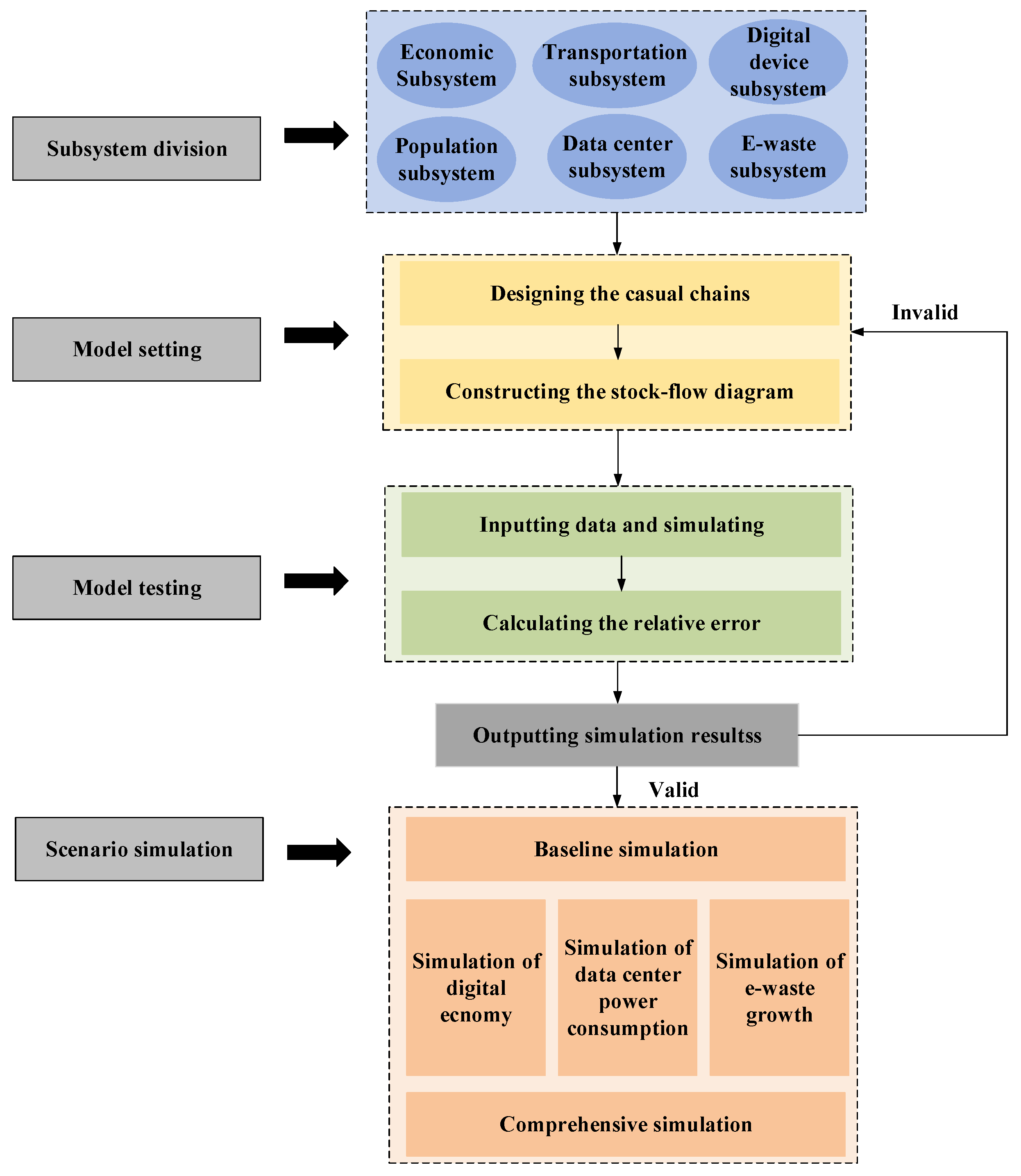
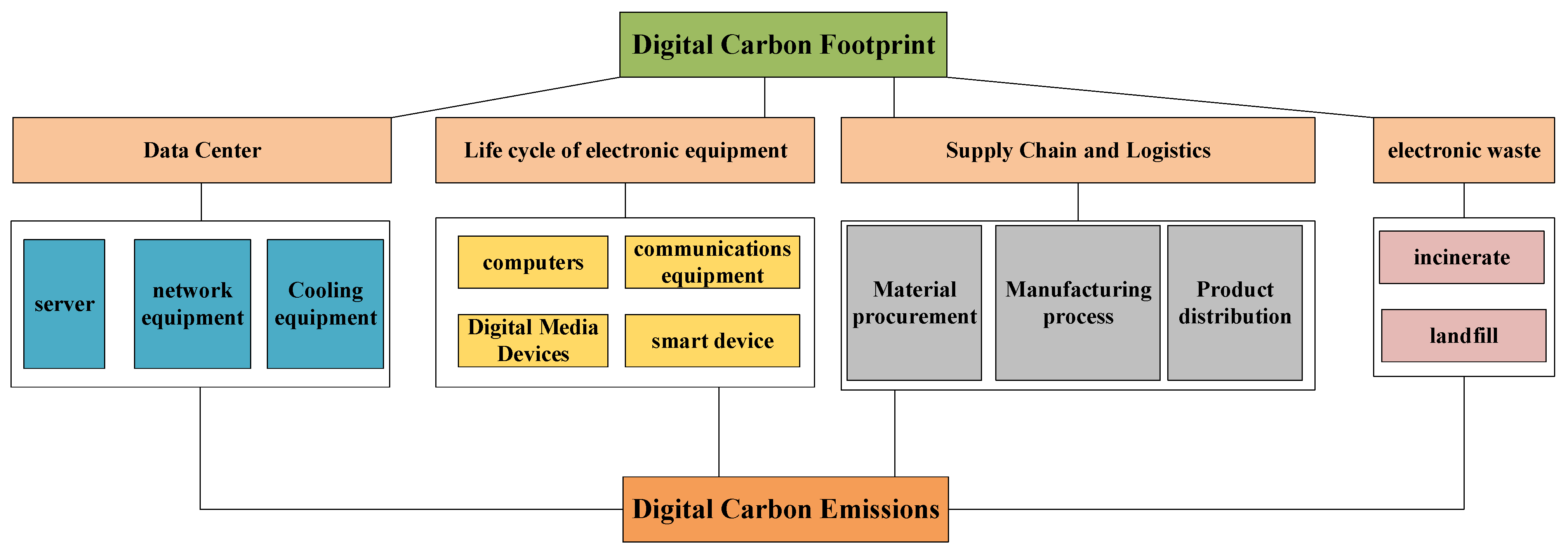
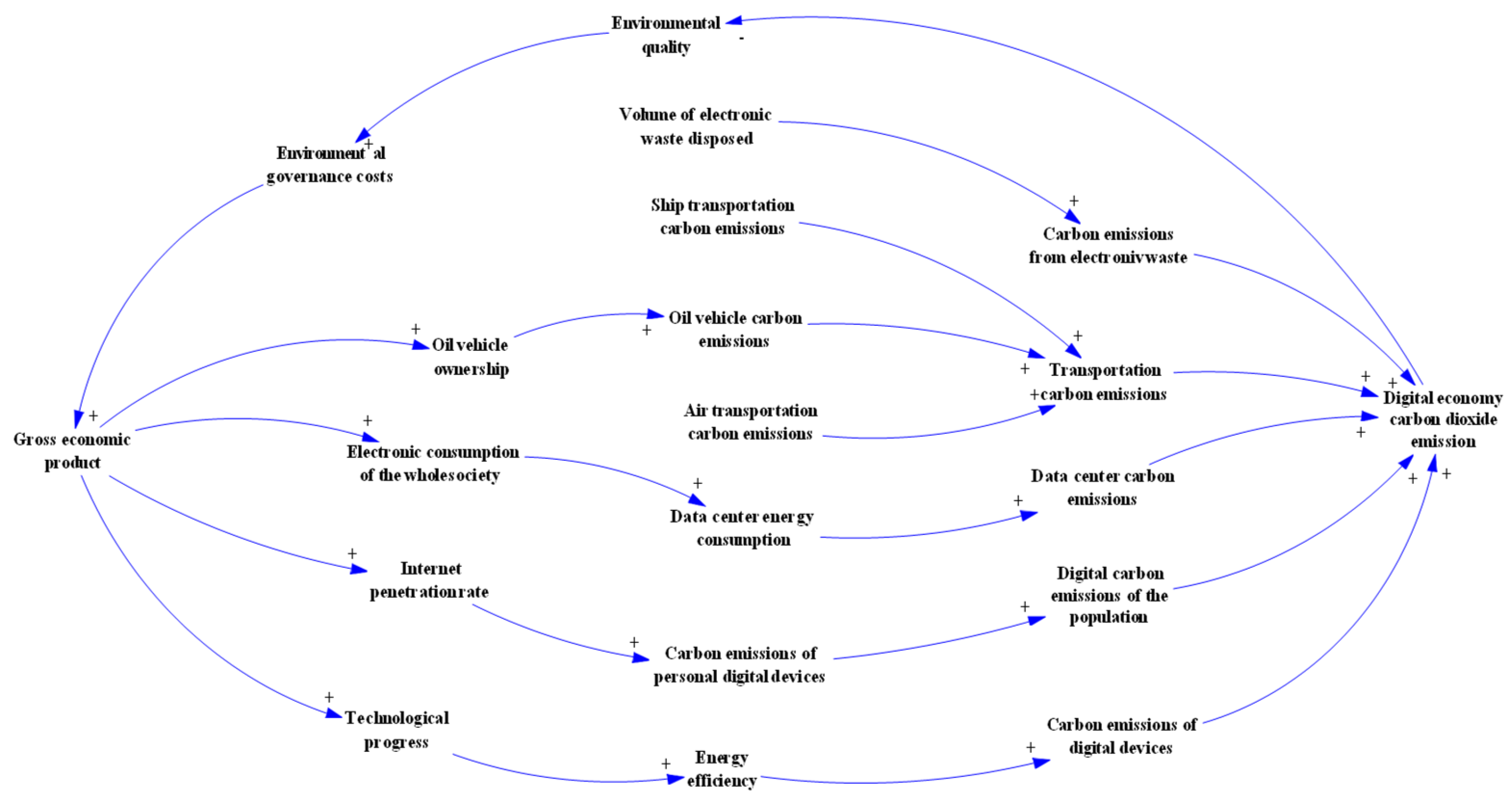


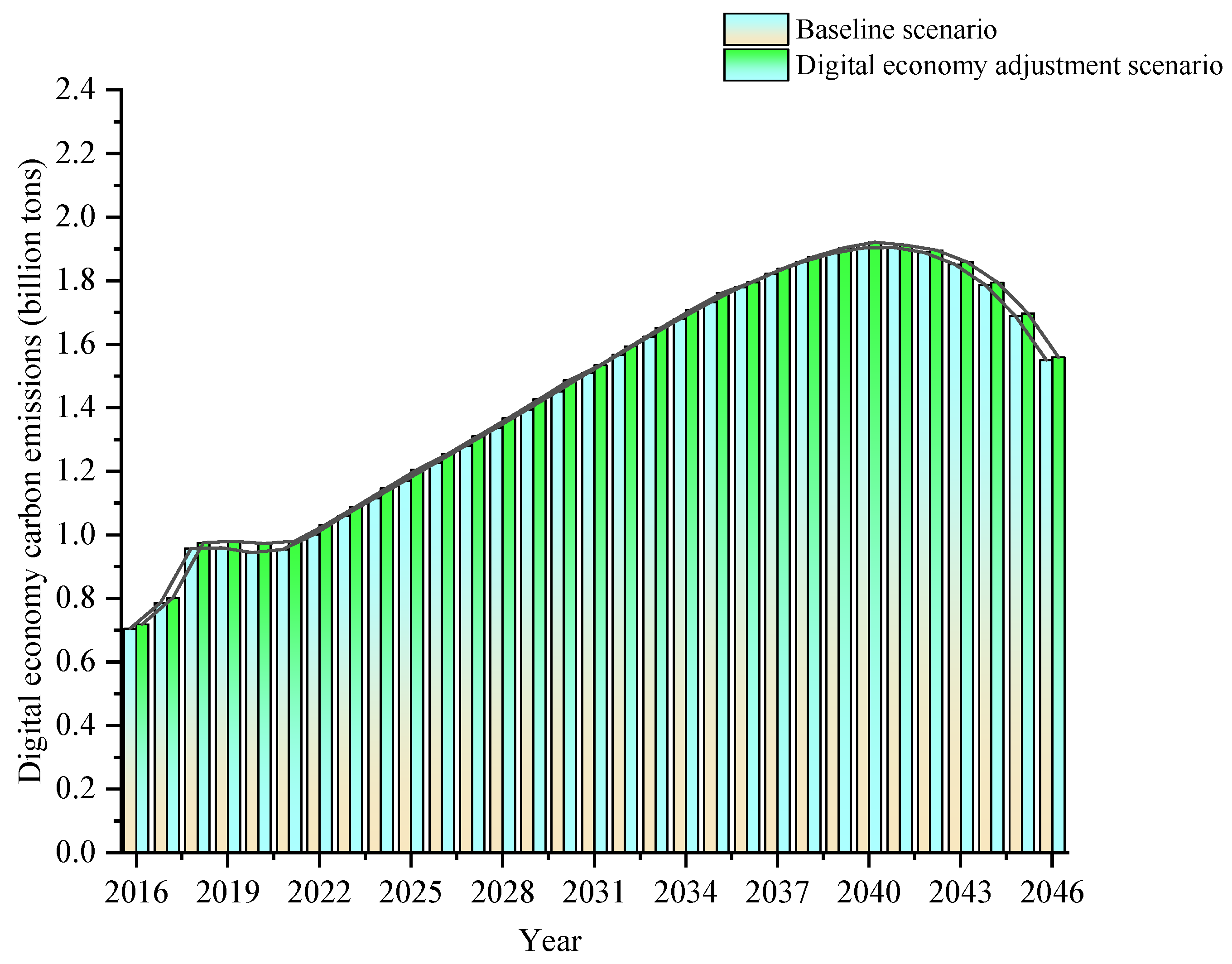
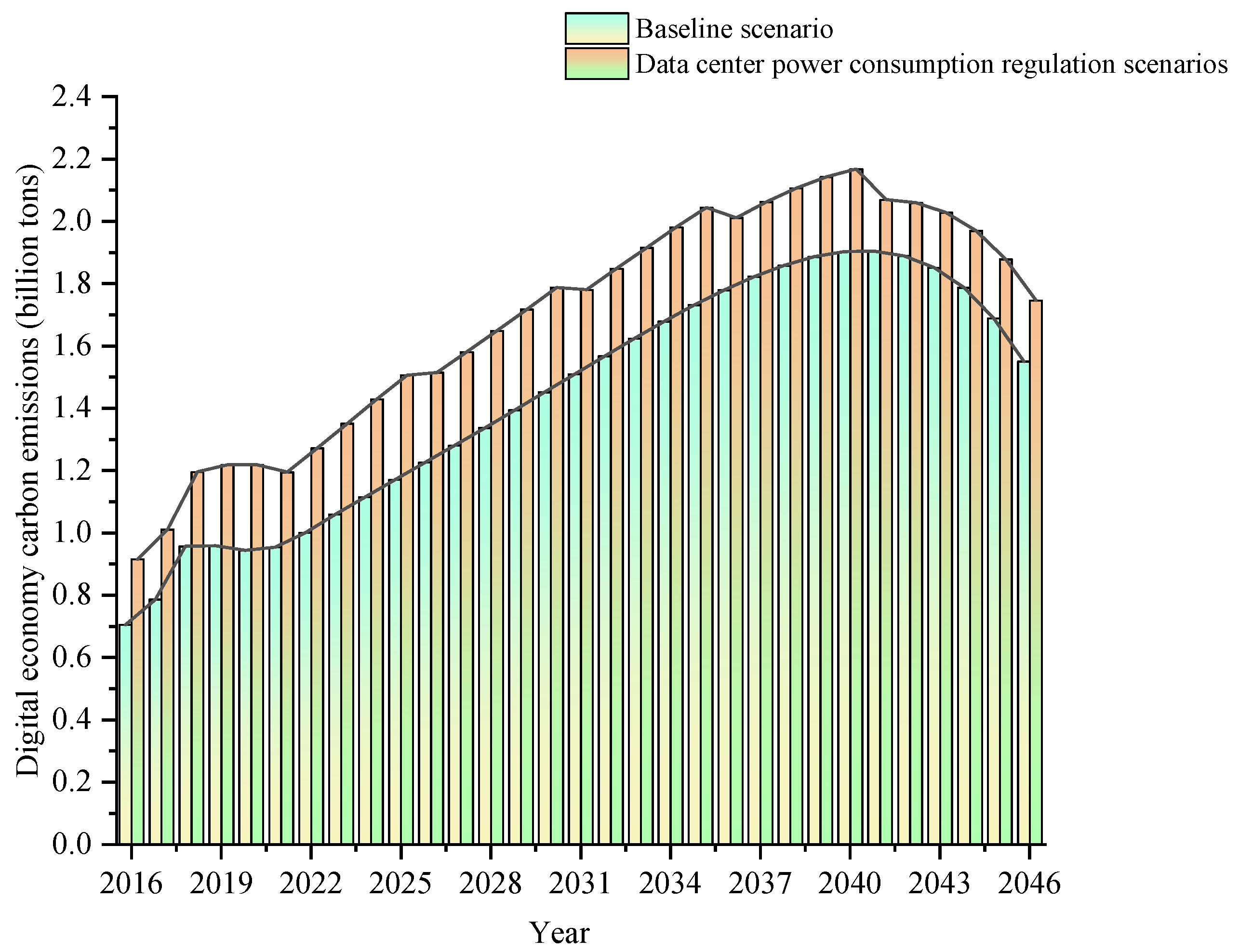

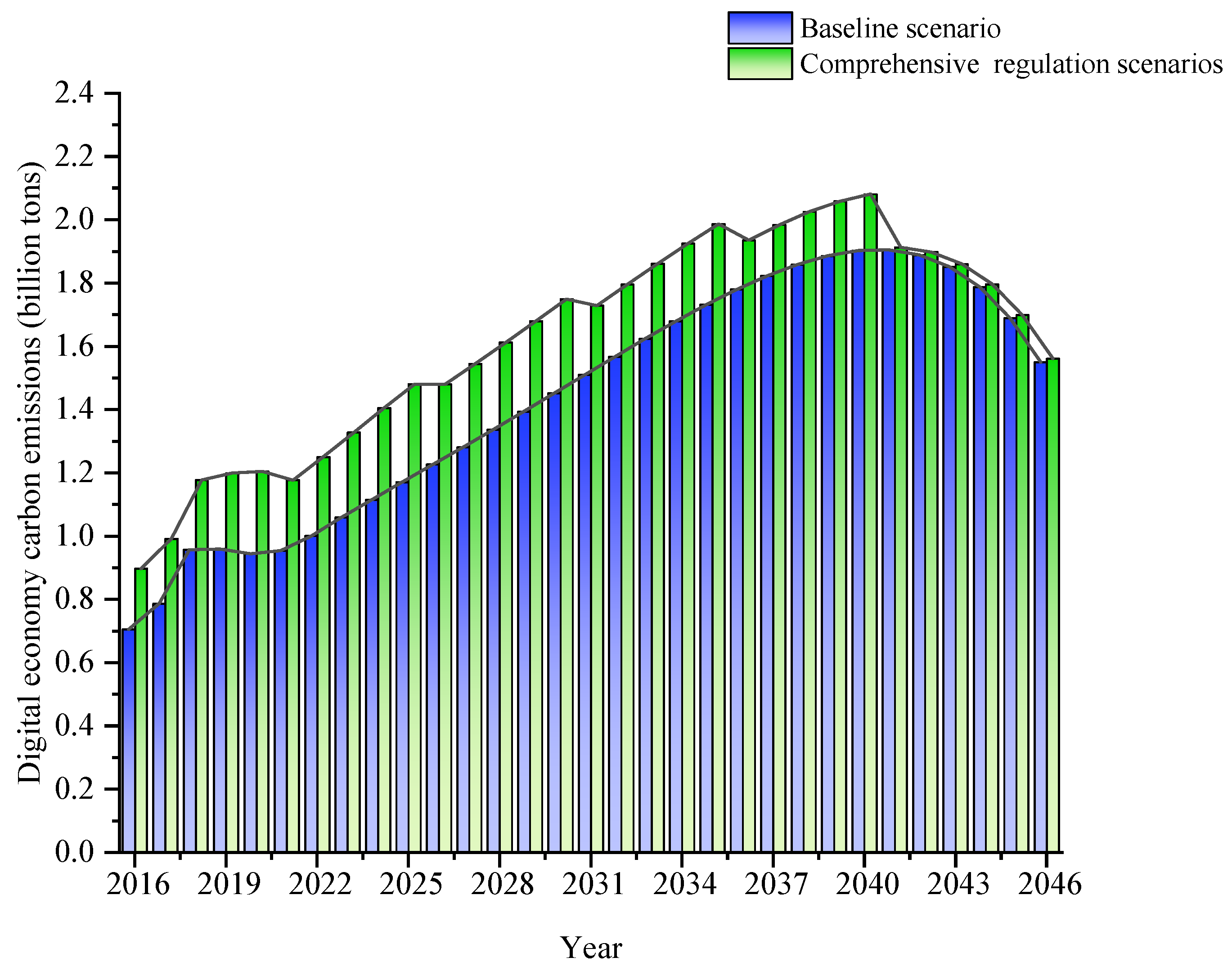
| Subsystems | Key Variables |
|---|---|
| Economic development subsystem | Gross domestic product, growth in economy, economic growth rate, financial revenue, percentage of digital economy, and technology investment |
| Transportation subsystem | Oil-vehicle production, oil-vehicle growth, oil-vehicle ownership, oil-vehicle scrapping growth, oil-vehicle scrapping growth rate, oil-vehicle carbon emission factor, air transportation carbon emission, ship transportation carbon emission, and aviation carbon emission growth |
| Digital device energy consumption subsystem | Energy consumption growth of digital devices, energy consumption growth rate of digital devices, energy consumption of digital devices, energy efficiency, carbon emissions of digital devices, and energy carbon emission factor |
| Population subsystem | Population size, population growth, population decline, birth rate, natural population growth rate, mortality rate, digital economy carbon emissions of the population, and Internet penetration rate |
| Data center energy consumption subsystem | Power consumption growth, power consumption growth rate, data center carbon emission, data center power consumption percentage, electricity carbon emission factor, and data center energy consumption |
| E-waste discharge subsystem | Average e-waste carbon emission, e-waste disposal, e-waste carbon emission, and e-waste growth rate |
| Scenarios | Scenarios Features | Model Adjustment |
|---|---|---|
| Scenario 1 | No policy restrictions | No additional adjustments |
| Scenario 2 | Digital economy scaling adjustment | Controlling the pace of digital economy development and setting different scenarios for digital economy percentage |
| Scenario 3 | Data center power consumption adjustment | Adjusting the percentage of power consumption in the data center and setting up different energy consumption scenarios |
| Scenario 4 | E-waste growth rate adjustment | Adjusting e-waste growth rates and setting different e-waste growth rates |
| Scenario 5 | Comprehensive adjustment | Combined adjustments |
| Time Period | 2016–2020 | 2021–2025 | 2026–2030 | 2031–2035 | 2035–2040 | 2040–2045 |
|---|---|---|---|---|---|---|
| Percentage of digital economy | 30% | 35% | 40% | 45% | 50% | 55% |
| Time Period | 2016–2020 | 2021–2025 | 2026–2030 | 2031–2035 | 2035–2040 | 2040–2045 |
|---|---|---|---|---|---|---|
| Percentage of data center power consumption | 30% | 35% | 40% | 45% | 50% | 55% |
| Time Period | 2016–2020 | 2021–2025 | 2026–2030 | 2031–2035 | 2035–2040 | 2040–2045 |
|---|---|---|---|---|---|---|
| E-waste growth rate regulation | 30% | 35% | 40% | 45% | 50% | 55% |
| Time Period | 2016–2020 | 2021–2025 | 2026–2030 | 2031–2035 | 2035–2040 | 2040–2045 |
|---|---|---|---|---|---|---|
| Percentage of digital economy | 30% | 35% | 40% | 45% | 50% | 55% |
| Percentage of data center power consumption | 2.1% | 1.9% | 1.7% | 1.5% | 1.3% | 1% |
| E-waste growth rate regulation | 6.5% | 6.0% | 5.5% | 5.0% | 4.8% | 4.5% |
| Year | Gross Economic Product (GDP) | Electricity Consumption of the Whole Society | Population Size | ||||||
|---|---|---|---|---|---|---|---|---|---|
| Real Value | Simulation Value | Error Rate | Actual Value | Simulation Value | Error Rate | Actual Value | Simulation Value | Error Rate | |
| 2016 | 746,395.1 | 746,378.0 | −0.002 | 61,205.1 | 61,849.3 | 1.050 | 139,232 | 137,943 | −0.926 |
| 2017 | 832,035.9 | 831,987.0 | −0.006 | 65,914.0 | 65,900.5 | −0.020 | 140,011 | 138,426 | −1.132 |
| 2018 | 919,281.1 | 919,180.0 | −0.011 | 71,508.2 | 71,502.0 | −0.008 | 140,541 | 138,910 | −1.161 |
| 2019 | 986,515.2 | 1,015,600.0 | 2.940 | 74,866.1 | 75,506.1 | 0.850 | 141,008 | 139,397 | −1.142 |
| 2020 | 1,013,567.0 | 1,018,940.0 | 0.500 | 77,620.2 | 78,488.6 | 1.120 | 141,212 | 139,884 | −0.940 |
Disclaimer/Publisher’s Note: The statements, opinions and data contained in all publications are solely those of the individual author(s) and contributor(s) and not of MDPI and/or the editor(s). MDPI and/or the editor(s) disclaim responsibility for any injury to people or property resulting from any ideas, methods, instructions or products referred to in the content. |
© 2024 by the authors. Licensee MDPI, Basel, Switzerland. This article is an open access article distributed under the terms and conditions of the Creative Commons Attribution (CC BY) license (https://creativecommons.org/licenses/by/4.0/).
Share and Cite
Xu, R.; Ji, K.; Yuan, Z.; Wang, C.; Xia, Y. Exploring the Evolution Trend of China’s Digital Carbon Footprint: A Simulation Based on System Dynamics Approach. Sustainability 2024, 16, 4230. https://doi.org/10.3390/su16104230
Xu R, Ji K, Yuan Z, Wang C, Xia Y. Exploring the Evolution Trend of China’s Digital Carbon Footprint: A Simulation Based on System Dynamics Approach. Sustainability. 2024; 16(10):4230. https://doi.org/10.3390/su16104230
Chicago/Turabian StyleXu, Ruiheng, Kaiwen Ji, Zichen Yuan, Chenye Wang, and Yihan Xia. 2024. "Exploring the Evolution Trend of China’s Digital Carbon Footprint: A Simulation Based on System Dynamics Approach" Sustainability 16, no. 10: 4230. https://doi.org/10.3390/su16104230
APA StyleXu, R., Ji, K., Yuan, Z., Wang, C., & Xia, Y. (2024). Exploring the Evolution Trend of China’s Digital Carbon Footprint: A Simulation Based on System Dynamics Approach. Sustainability, 16(10), 4230. https://doi.org/10.3390/su16104230






